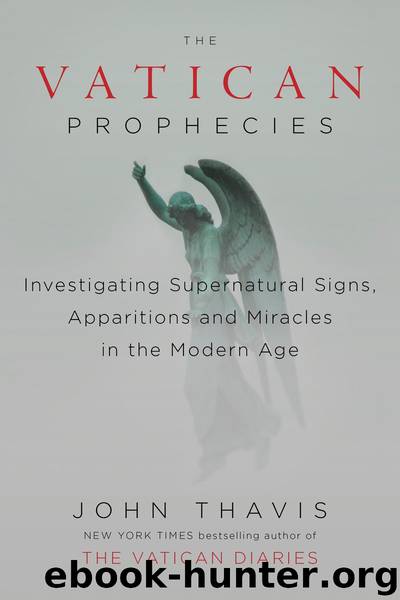The Vatican Prophecies: Investigating Supernatural Signs, Apparitions, and Miracles in the Modern Age by John Thavis

Author:John Thavis
Language: eng
Format: mobi, epub, azw3
Publisher: Penguin Publishing Group
Published: 2015-09-15T04:30:00+00:00
Then war broke out in heaven; Michael and his angels battled against the dragon.
—THE BOOK OF REVELATION
Popularized as secret spiritual allies through the centuries, depicted in modern films—with or without wings—as ambassadors to God or celestial bearers of life’s second chance, angels have always represented heaven’s heroic warriors in the struggle against evil in general and Satan in particular. Frequent protagonists in both the Old and New Testaments, in the latter it was angels who announced Jesus’s birth, ministered to him in the desert, and comforted him in his agony. Every pope, at one time or another, has endorsed the invisible activity of the angelic host. John Paul II gave a series of talks on angels, stating “they do exist” and have a “fundamental role to play in the unfolding of human events.” Even the highly rationalist Pope Benedict XVI once said guardian angels were “ministers of divine care for every person,” offering protection from birth to death.
In recent years, though, the Vatican has repeatedly intervened to curb what it considers extreme and unfounded beliefs about angels and their role in human affairs. Arguably church officials have given more attention to excessive angel worship than to Satanic cults. Whether its focus is on angels or demons, the Vatican’s chief concern is that Catholics might believe that the world is caught up in a supernatural struggle between good and evil spirits over which human beings have no control.
In 2002, alarmed that the traditional role of angels was being contaminated by New Age movements and modern forms of superstition, the Vatican issued a document that warned against “deviations” in angelic veneration. Salvation is a progressive spiritual journey that requires effort by individuals, it stated, and it was “childish” to “ascribe all setbacks to the devil and all success to the guardian angels.” In particular, it took aim at cults that featured a full roster of angels, each with their own names, personalities, and superpowers. The only angels that should be identified, the Vatican made clear, were those named in Scripture: Michael, Raphael, and Gabriel.
Most cases of exaggerated veneration of angels are handled quietly, before they can be publicized and promoted. But one angel cult that arose in Europe has proven especially problematic, requiring multiple warnings from the Vatican’s doctrinal officials. Engelwerk, also known as Opus Angelorum (Work of the Holy Angels), was founded in the late 1940s by a Tyrolean housewife, Gabriele Bitterlich, who claimed she had experienced visions revealing the names, appearances, and job descriptions of hundreds of angels and demons engaged in an endless battle. She filled tens of thousands of pages with detailed accounts of angels’ activities, which formed the basis of her movement. It turned out that many Catholics were eager not only to become acquainted with the angelic hierarchy but also to dedicate their lives to them. Some of the names of angels had a Kabbalistic ring, or seemed borrowed from other esoteric texts. A handbook published by Opus Angelorum described Astaroth, whose “attacking light is visible over Rome,” and Gethuliel, whose laugh rings out “like a silver bell.
Download
The Vatican Prophecies: Investigating Supernatural Signs, Apparitions, and Miracles in the Modern Age by John Thavis.epub
The Vatican Prophecies: Investigating Supernatural Signs, Apparitions, and Miracles in the Modern Age by John Thavis.azw3
This site does not store any files on its server. We only index and link to content provided by other sites. Please contact the content providers to delete copyright contents if any and email us, we'll remove relevant links or contents immediately.
Resisting Happiness by Matthew Kelly(3200)
The Social Psychology of Inequality by Unknown(2773)
Designing Your Life by Bill Burnett(2606)
Day by Elie Wiesel(2599)
The Giving Tree by Shel Silverstein(2178)
Angels of God: The Bible, the Church and the Heavenly Hosts by Mike Aquilina(1871)
Human Design by Chetan Parkyn(1859)
The Supreme Gift by Paulo Coelho(1802)
Jesus of Nazareth by Joseph Ratzinger(1710)
Augustine: Conversions to Confessions by Robin Lane Fox(1688)
Hostage to the Devil by Malachi Martin(1676)
7 Secrets of Divine Mercy by Vinny Flynn(1623)
Dark Mysteries of the Vatican by H. Paul Jeffers(1607)
The Vatican Pimpernel by Brian Fleming(1589)
St. Thomas Aquinas by G. K. Chesterton(1559)
Saints & Angels by Doreen Virtue(1532)
The Ratline by Philippe Sands(1425)
My Daily Catholic Bible, NABRE by Thigpen Edited by Dr. Paul(1418)
Called to Life by Jacques Philippe(1411)
